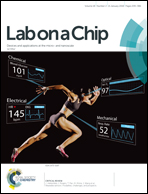Microfluidic bypass manometry: highly parallelized measurement of flow resistance of complex channel geometries and trapped droplets†
Abstract
Current lithography methods allow facile fabrication of microfluidic conduits where not only the shape of the bounding walls can be arbitrarily varied but also the internal conduit space can be laden with a variety of microstructures and wetting properties. This virtually infinite design space of microfluidic geometries brings in the challenge of how to quantify fluid resistance in a large number of microfluidic conduits, while maintaining operational simplicity. We report a versatile experimental technique referred to as microfluidic bypass manometry for measurement of pressure drop versus flow rate (ΔP–Q) relations in a parallelized manner. The technique involves introducing co-flowing laminar streams into a microfluidic network that contains a series of loops, where each loop is comprised of a test geometry and a bypass channel as a flow-rate sensing element. We optimize the network geometry and present operational considerations for microfluidic bypass manometry. To demonstrate the power of our technique, we used single-phase fluids and measured ΔP–Q relations simultaneously for forty test geometries ranging from linear to contraction–expansion to serpentine to pillar-laden microchannels. To expand the capabilities of the method, we measured ΔP–Q relations for similar-sized oil droplets trapped in microcavities where the cavity geometry spans from prisms of 3–10 sides to circular disks. We found in all cases, the ΔP–Q relation is nonlinear and the flow resistance of droplets is sensitive to confinement. At high flow rates, the drop resistance depends on the cavity geometry and is higher in a triangular prism compared to a circular disk. We compared the measured flow resistance of single-phase fluids and droplets in different microfluidic geometries to that from computational fluid dynamics simulations and found them to be in excellent agreement. Given the simplicity and versatility of the microfluidic bypass manometry method, we anticipate that it may find broad application in several areas including design of lab-on-chip devices, laminar drag reduction and mechanics of deformable particles.



 Please wait while we load your content...
Please wait while we load your content...